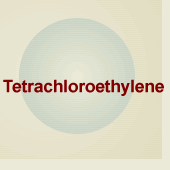Tetrachloroethylene (Perchloroethylene)
On this Page

NIOSH Resources
NIOSH Pocket Guide to Chemical Hazards
Exposure limits, Respirator Recommendations, First Aid, more...
The Pocket Guide is a source of general industrial hygiene information on several hundred chemicals/classes found in the work environment. Key data provided for each chemical/substance includes name (including synonyms/trade names), structure/formula, CAS/RTECS Numbers, DOT ID, conversion factors, exposure limits, IDLH, chemical and physical properties, measurement methods, personal protection, respirator recommendations, symptoms, and first aid.
- Tetrachloroethylene (CAS No. 127-18-4)
International Chemical Safety Cards
An ICSC summarizes essential health and safety information on chemicals for their use at the "shop floor" level by workers and employers in factories, agriculture, construction and other work places.
Documentation for Immediately Dangerous to Life or Health Concentrations (IDLH)
The IDLH documents the criteria and information sources that have been used by NIOSH to determine immediately dangerous to life or health concentrations.
NIOSH Manual of Analytical Methods (NMAM)
NMAM is a collection of methods for sampling and analysis of contaminants in workplace air, and in the blood and urine of workers who are occupationally exposed.
- Hydrocarbons, Halogenated (No. 1003)
- Perchloroethylene (port GC) in exhaled breath and air (No. 3704)
NIOSH Worker Notification Program
NIOSH conducts research to prevent illnesses and injuries in the workplace. The NIOSH worker Notification Program notifies workers and other stakeholders about the findings of these research studies.
NIOSH Safety and Health Topic: Drycleaning
Provides a collection of resources focused upon identifying and controlling the exposure of workers to tetrachloroethylene (perchloroethylene), as well as other hazards.
NIOSH Criteria Documents: Criteria for a Recommended Standard: Occupational Exposure to Tetrachloroethylene
DHHS (NIOSH) Publication No. 76-185 (1976)
Presents a standard to prevent the adverse effects of exposure to tetrachloroethylene over a working lifetime.
Current Intelligence Bulletin No. 20: Tetrachloroethylene
DHHS (NIOSH) Publication No. 78-111 (1978)
This Bulletin is to advise you of the findings of the NCI study, other pertinent data, their implications for occupational health, and precautions for handling tetrachloroethylene.
Occupational Safety and Health Guideline for Tetrachloroethylene
Related Resources
ATSDR's Medical Management Guidelines (MMGs): Tetrachloroethylene
Agency for Toxic Effects Disease Registry - ToxFAQs: Tetrachloroethylene
ATSDR (Case Studies in Environmental Medicine): Tetrachloroethylene
Toxicological Profile for Tetrachloroethylene (ATSDR)
OSHA Safety and Health Topics: Tetrachloroethylene
Provides information about the physical properties, health factors, exposure limits, and monitoring methods used by OSHA for tetrachloroethylene.
OSHA (Chemical Sampling Information): Tetrachloroethylene
New Jersey Hazardous Substance Fact Sheets: Tetrachloroethylene
Canadian Centre for Occupational Health and Safety: Tetrachloroethylene
Acute Exposure Guideline Levels (AEGLs) (EPA): Tetrachloroethylene
EPA (Air Toxics): Tetrachloroethylene
EPA Consumer Fact Sheet (Ground and Drinking Water): Tetrachloroethylene
EPA (OPPT Chemical Fact Sheet): Perchloroethylene
Integrated Risk Information System (IRIS): Tetrachloroethylene
NLM (Hazardous Substance Data Bank): Tetrachloroethylene
NLM (Haz-Map): Tetrachloroethylene
NLM (Household Products Database): Tetrachloroethylene
European chemical Substances Information System (ESIS): Tetrachloroethylene
NTP Report on Carcinogens (Twelfth Edition, 2011): Tetrachloroethylene
IARC Monograph (Vol. 63): Tetrachloroethylene
WHO (CICAD 68): Tetrachloroethylene
- Page last reviewed: October 14, 2009
- Page last updated: October 25, 2010
- Content source:
- National Institute for Occupational Safety and Health Education and Information Division


 ShareCompartir
ShareCompartir